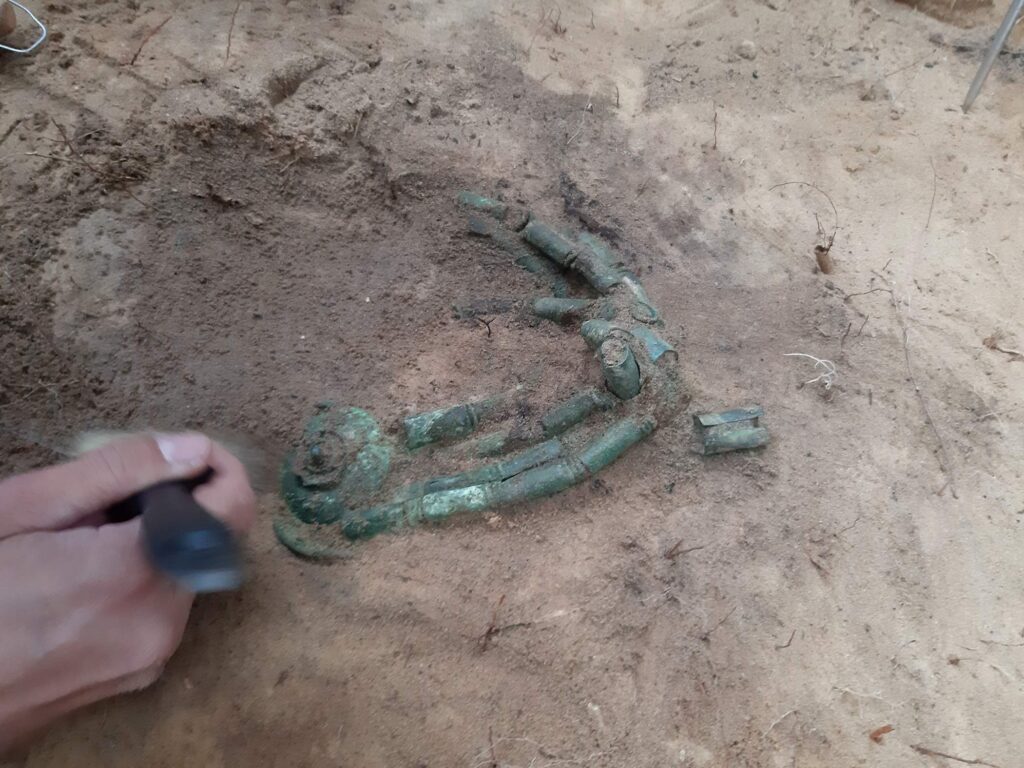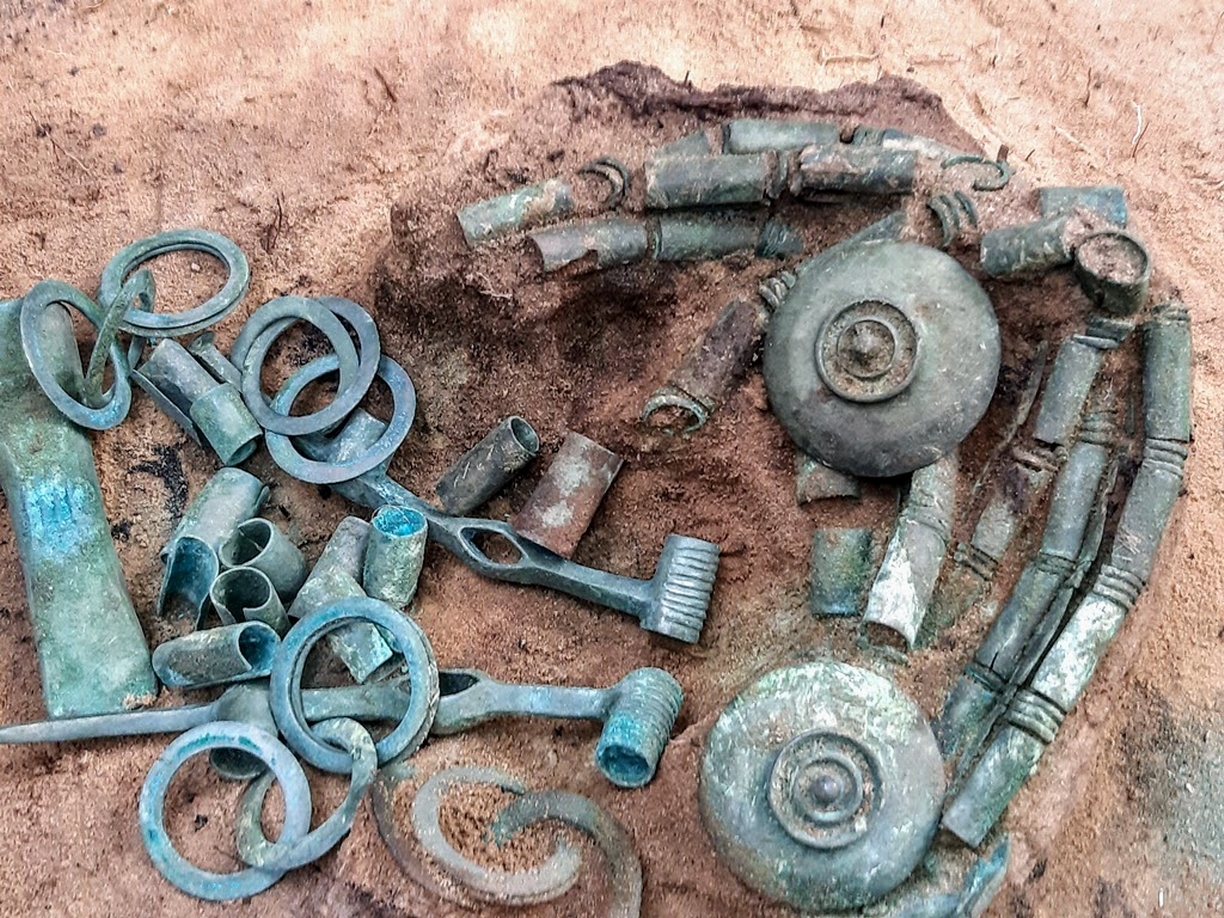W sobotni pochmurny poranek, razem z grupą Weles spotkaliśmy się na wspólne poszukiwania. Byliśmy sceptycznie nastawieni do poszukiwań, ponieważ od samego rana padał deszcz. O godzinie 10.00 zaczęło się przejaśniać. Po zbiórce i omówieniu miejsca poszukiwań, ruszyliśmy w teren. Po kilku godzinach, koledzy z grupy zakończyli poszukiwania i udali się w umówione miejsce na odpoczynek przy ognisku. Kierując się w drogę powrotna, zauważyłem że teren jest w miarę czysty, więc podniosłem czułość wykrywacza. Po kilkunastu metrach usłyszałem sygnał.
Wiedząc że to już koniec poszukiwań, postanowiłem jeszcze dać sobie szansę, i sprawdzić co jest pod cewką. Nie mogąc namierzyć sygnału zrobiłem dość duży, lecz płytki wykop na około 25cm. Nie sądziłem, że szukany sygnał może być tak głęboko, a jednak, na głębokości około 45 cm używając pinpointera wyczułem że coś tam jest. Sięgając głęboko ręką, wyciągnąłem pierwsze elementy, które nie wydawały się niczym specjalnym. Dopiero po wyciągnięciu toporka pomyślałem, że może to być coś naprawdę starego, więc postanowiłem powiadomić o tym grupę. Na poszukiwaniach oprócz mnie pozostał jeszcze tylko Dominik Mirowski, który przyszedł na miejsce znaleziska, i skontaktował się telefonicznie z Arkiem Wyrzykowskim, również wysyłając mu zdjęcia.
Stwierdzając że może to być coś cennego, dostaliśmy informację, aby zaprzestać dalszej eksploracji gdyż to może być zabytek. Nakazał zasypać delikatnie dołek, i dobrze zamaskować, a wybrane elementy delikatnie przenieść do reszty grupy. Tam już po pierwszym rzucie okiem okazało się, że jest to toporek tulejowaty, a reszta przedmiotów pozostała zagadką. Powiadomiliśmy konserwatora zabytków. Przez kilka dni pilnowaliśmy miejsca, w którym został znaleziony skarb. W umówiony dzień, pojechaliśmy tam wraz z archeologami w celu wydobycia skarbu. Udało się. Emocje ogromne.
Skarbem okazało się ponad 150 zdobionych fragmentów uprzęży końskiej z brązu z przed ponad 2,5 tysiąca lat. Zdaniem badaczy przedmioty były zawinięte w liście i włożone do skórzanego worka. To pierwsze tego typu odkrycie z obszaru Środkowo Wschodniej Europy – uważają naukowcy. Uważają również że stylistyka odkrytych zabytków nie pozostawia cienia wątpliwości, iż jest to ślad daleko na północ sięgającej infiltracji nomadów, być może Scytów, w środowisku ludności kultury łużyckiej. Najpewniej miało to miejsce we wczesnej epoce żelaza. Skarb ostatecznie trafi do jednego z lokalnych muzeów. Obecnie jest szczegółowo analizowany i poddawany konserwacji. Infarmacja o tym znalezisku obiegła media w całej Polsce, oraz za granicą. Jestem bardzo dumny z tego skarbu, i z niecierpliwością czekam na kolejne poszukiwania. Pozdrawiam Arkadiusz Kurij
--------------------------------------------------------------------------------------------------------------------
On a cloudy Saturday morning, together with the Weles group, we met for a joint search. We were skeptical about the search because it was raining from the very morning. At 10.00 it started to clear up. After collecting and discussing the search site, we went to the field. After a few hours, the friends from the group finished their search and went to the agreed place to rest by the fire. On my way back, I noticed that the area was relatively clean, so I increased the detector's sensitivity. After a dozen or so meters, I heard a signal.
Knowing that this is the end of the search, I decided to give myself a chance and check what's under the coil. Unable to locate the signal, I made a fairly large but shallow excavation of about 25 cm. I did not think that the signal I was looking for could be so deep, and yet, at a depth of about 45 cm, using a pinpointer, I sensed that something was there. Reaching deep with my hand, I pulled out the first elements that didn't seem special. It wasn't until I pulled out the hatchet that I thought it might be something really old, so decided to let the group know. Apart from me, only Dominik Mirowski remained on the search, who came to the place of the find and contacted Arek Wyrzykowski by phone, also sending him photos.
Stating that it could be something valuable, we were informed to stop further exploration as it could be a monument. He ordered the hole to be gently covered and masked well, and the selected elements should be gently transferred to the rest of the group. There, after the first glance, it turned out that it was a bush hatchet, and the rest of the items remained a mystery. We notified the conservator of monuments. For several days, we guarded the place where the treasure was found. On the agreed day, we went there together with the archaeologists to extract the treasure. Managed to. Huge emotions.
The treasure turned out to be over 150 decorated fragments of bronze horse harness from over 2,500 years ago. According to the researchers, the items were wrapped in leaves and put in a leather bag. This is the first discovery of this type from the area of Central and Eastern Europe, scientists believe. They also believe that the style of the discovered monuments leaves no doubt that it is a trace of the far north infiltration of nomads, perhaps Scythians, in the environment of the Lusatian culture. This was most likely in the early Iron Age. The treasure will eventually go to one of the local museums. It is currently being carefully analyzed and maintained. Information about this discovery circulated in the media all over Poland and abroad. I am very proud of this treasure, and I look forward to the next search.





















